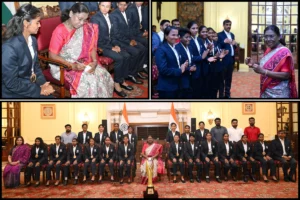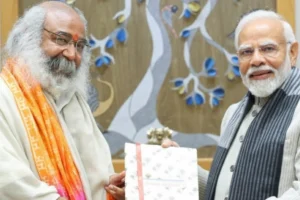
India, known for its diversity and multi-religious society, has managed to achieve a unique unity and peaceful coexistence among its people, which is remarkable considering the challenges faced by many multi-religious societies around the world.
The driving force behind this unity can be attributed to the long-standing syncretic traditions in Indian society.
In India, the multicultural social setup has been strengthened through improvisations, adjustments, mutual respect, and the conceptualization of a transcendental life that goes beyond religious and cultural stereotypes. This has been possible through the influence of syncretic traditions such as Sufism, Bhakti, and other mystical practices. These traditions have played a significant role in fostering unity, and peaceful coexistence, and becoming an integral part of the socio-religious life of the people.
Mysticism, which involves seeking hidden meaning and a connection with God through deep prayer or contemplation, is particularly embraced by Sufis and Bhaktas in India. These movements emerged as inclusive reactions to exclusive interpretations and practices within Hinduism and Islam, allowing common people to express their inner sentiments and actively participate in the process of loving the Divine.
India has a long history of syncretism, even before the arrival of Islam and Christianity. The diverse nature of Hinduism, with its various sects and deities, required the tradition of syncretism to prevent hostility among followers. The advent of Buddhism and Jainism further complicated the religious landscape, making syncretism essential for harmony.
The proponents of the Bhakti tradition played a significant role in introducing syncretic traditions in Hinduism. The tradition of ‘Sants’ helped consolidate this syncretism. The Sants, influential figures in the movement, emphasized fulfilling social obligations while maintaining inner detachment from worldly ties. They rejected traditional rituals, caste barriers, and religious divisions, advocating for love that embraced humanity and the abstract concept of God.
The syncretism of the Bhakti movement later became a bridge between Hinduism and Islam, harmonizing elements of both faith systems. The Sants, like Kabir, criticized the orthodoxies of Hinduism and Islam. Their teachings attracted followers from diverse religious backgrounds, creating a syncretic space where the exclusivity of a particular religion became less relevant.
Islamic mysticism, represented by Sufism, arrived in India with the establishment of the Delhi Sultanate. Sufi orders, such as Chistiyya and Suhrawardiyya, spread through numerous khanqahs (spiritual centers). Sufism offered an alternative perspective on life and its relationship with God compared to the more orthodox elements of Islam represented by the Ulama.
Mystic and syncretic traditions are not limited to Hinduism and Islam in India but are also prevalent in other prominent religions such as Buddhism, Sikhism, and Jainism. Buddhism emerged as a distinct religion separate from Hinduism, but over time, it incorporated syncretic elements to make it more acceptable to the masses. Even though Buddhism declined in popularity in India, its ideas and ideals were incorporated into the broader fold of Hinduism.
Sikhism can be considered one of the most syncretic religions in India. Its founder, Guru Nanak, was influenced by the Sant tradition, Upanishadic metaphysics, and teachings of Islam and the Nath Yogis. Nanak rebelled against ritualism and caste rigidities, emphasizing worship, submission to God’s will, honest labour, and collective sharing. The holy book of Sikhs, the Granth Sahib, consists of writings from people of different religions, highlighting the syncretic nature of their faith.
Jainism, despite being a distinct religious order, remains deeply embedded in the ideals and virtues of Hinduism. Its philosophical stipulations revisit the loftier ideals found in Hindu scriptures, resulting in little divergence between Hinduism and Jainism in practical aspects.
Satpanth is considered a syncretism of Ismaili Islam and Hinduism. Satpanth is a syncretic religious movement that emerged in the Indian subcontinent. It is considered a fusion of Ismaili Islam and Hinduism. Satpanth followers believe in the spiritual authority of the Imam, who they consider to be the rightful successor of Prophet Muhammad. They also incorporate Hindu rituals and beliefs into their practices, such as reverence for Hindu deities and pilgrimage to Hindu temples. Satpanth emphasizes moral values, spiritual enlightenment, and devotion to God. The movement has a significant presence in Gujarat and Rajasthan, with a diverse community of followers from different castes and backgrounds.
The Meivazhi religion is a syncretic monotheistic minority religion based in Tamil Nadu, India. It emphasizes spiritual enlightenment and overcoming death through its teachings. Meivazhi incorporates the teachings of various major religions, including Hinduism, Buddhism, Islam, Judaism, and Christianity, promoting the message of the oneness of essence found in these scriptures.
One of the remarkable aspects of Meivazhi is that it brings together people from 69 different castes and different religions, uniting them as one family within the Meivazhi religion.
Overall, the exchange of ideas and practices between different religious and mystical movements has contributed to the rich tapestry of Indian spirituality. The syncretic nature of these traditions has fostered inclusivity, unity, and a shared pursuit of spiritual truth.
In a world where religious differences can sometimes create divisions, the Sufi and Bhakti traditions serve as a reminder of the power of love, devotion, and the common essence that unites all humanity in their spiritual quest.
(Source – IANS)
To read more such news, download Bharat Express news apps





















